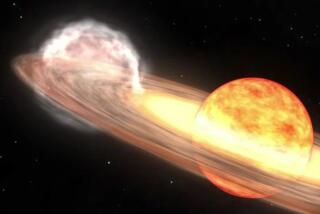Last Gasp Is a Real Show
- Share via
When a star in the sky collapses and dies, it sends out one last gasp of energy and matter and light that can be a hundred billion times greater than usual. If our sun were to do this, all life on Earth would die immediately, and the entire planet might be destroyed as well.
This event is called a supernova, and it is one of the rarest events in the sky. There are usually no more than two or three supernovae a century in a galaxy, and, since most galaxies are very far away, astronomers seldom get a good look at the death throes of a star. So supernovae remain mysterious events, though very important. It is believed that the heavier elements like the carbon in our bodies get thrust into the universe by supernovae.
The last supernova reasonably close to Earth was seen on Sept. 30, 1604, and was observed by Johannes Kepler, the astronomer who later discovered the laws of planetary motion. The last nearby supernova until this week, that is, when Ian Shelton of the University of Toronto, working at the Las Campanas observatory in Chile, spotted one in the Greater Magellanic Cloud--a group of small galaxies near our own Milky Way. The supernova is about 170,000 light years away, which means that the stellar explosion occurred about 170,000 years ago and the light has been traveling to Earth in the meantime.
This one should be the brightest star in the sky throughout the Southern Hemisphere for the next 10 days or more, but unfortunately it will not be visible in the continental United States. It should be quite a show, and a significant one at that. It reminds us that in the history of the universe there is nothing special about our time. The processes of nature go on, oblivious to us. It is also a chance to look into the future and see what happens to stars, for even they are not forever.






